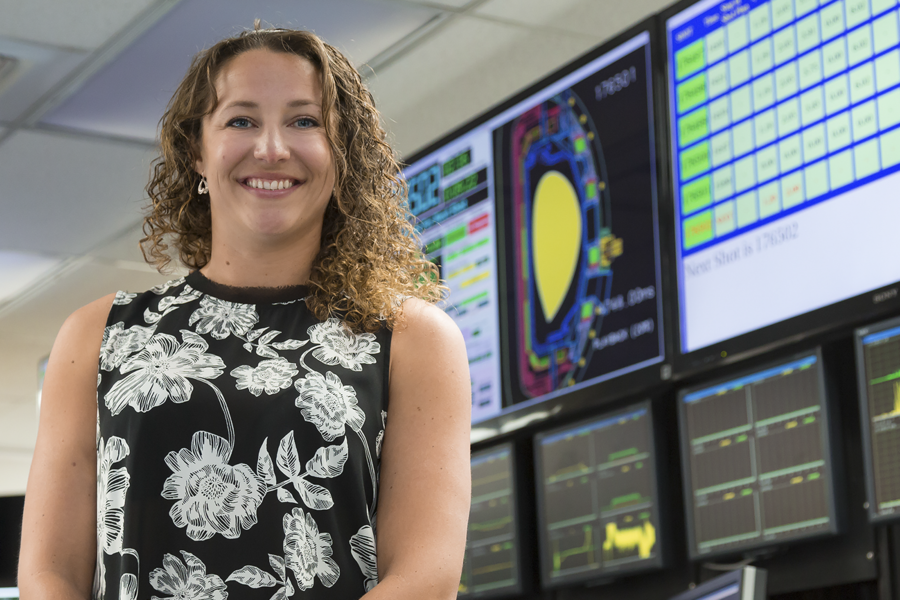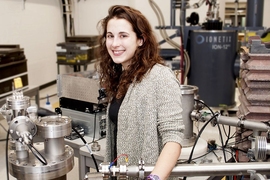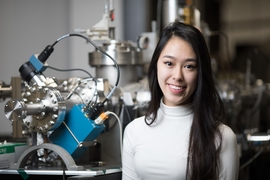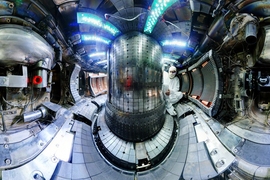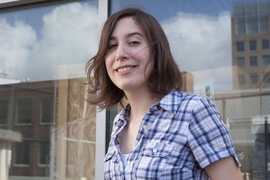Theresa Wilks has come full circle, at least geographically. After receiving a master's and PhD from Georgia Tech, she returned to her home state of California in 2016 as an MIT postdoc doing fusion energy research at the DIII-D tokamak, a national fusion reactor in San Diego. Her research is part of a growing collaboration MIT has with DIII-D.
“It’s funny because all the people in Boston say, ‘Oh, we can’t move to San Diego.’” She laughs, clearly relishing her location. “I’ll take one for the team. I’ll live in San Diego full time, and be the boots on the ground.”
MIT’s Plasma Science and Fusion Center (PSFC) has done research on the DIII-D tokamak since it began operations in the late 1980s, but collaboration activity has increased following the final operations on MIT’s Alcator C-Mod tokamak in September 2016. Wilks is part of the first wave of new postdocs deployed to DIII-D.
The project, led by PSFC principal research scientist Jerry Hughes, expands on research that was often a focus of Alcator C-Mod: controlling instabilities in the turbulent plasmas that fuel a fusion experiment. The plasma that swirls around the donut-shaped vacuum chamber of a tokamak is kept from damaging the walls by magnetic fields.
Wilks’s interest lies in the edge of the hot plasma closest to the tokamak’s chamber walls. Changes within these few centimeters, known as the ‘edge pedestal,’ can significantly affect the turbulence in the plasma, possibly leading to better control of the plasma and greater energy production.
Her path to energy research started in California where, as an undergraduate at University of California at Berkeley she did a mechanical engineering internship at a Chevron refinery in Richmond, the city where she had grown up.
“It was really interesting, but something just didn’t click,” she says. “I felt like a small cog in the wheel of a big machine.”
It wasn’t until she joined a thermal hydraulics lab at Berkeley that she developed a compelling interest in science research.
“When I started doing research I thought ‘Science research is the way to go.’ It’s so exciting to be at the forefront, pursuing your own ideas and to be developing things from scratch.”
A fellowship appointment at Lawrence Berkeley National Laboratory introduced her to research in heavy-ion fusion, and she took classes at Berkeley to support this new interest.
At Georgia Tech, a short-term master’s project familiarized her with tokamak plasmas, DIII-D, and the mysteries of the edge pedestal. She enjoyed the project so much that she continued to work on DIII-D data for her PhD.
Wilks was particularly interested in the radial electric field, shaped like a deep well, which is generated in the edge pedestal. Understanding how to calculate and control this field plays a role in suppressing plasma edge turbulence. For her doctoral research, she used DIIII-D data to develop models of the edge pedestal region of tokamak plasmas. This would allow her to predict the radial electric field and its impact on variables such as diffusion, heat flux, plasma rotation — and to figure out how to predict this in future reactors.
Today Wilks is happy to balance her talents for analysis and modeling with time at the helm of experiments.
“It is really exciting to work at a facility where we can test new hypotheses experimentally on a regular basis,” she says.
She is designing experiments to explore how to leverage turbulence in the edge pedestal to mitigate the impact of large instabilities in the plasma called edge localized modes (ELMs). She wants to reduce or completely eliminate them, creating a more stable environment for fusion energy reactions, and limiting the effects of heat and particles on the walls of the machine.
Given her background with DIII-D data, her project leader, Jerry Hughes, was not surprised that she “hit the ground running in no time.”
“She embedded herself in the experimental team, both analyzing existing tokamak data and designing new experiments. Now, more often than not, she is in the control room at DIII-D, part of a young generation that will need to operate the tokamaks of tomorrow.”
One of those future tokamaks could be SPARC, the recently proposed collaboration between MIT and Commonwealth Fusion Systems, which plans to use new superconducting technology to create a tokamak that will provide a faster, more compact and less expensive path to net fusion energy.
“By studying the edge boundary of both DIII-D and C-Mod, and applying modeling to the data, we can make big steps toward projecting to SPARC,” says Hughes.
Wilks is enthusiastic to go wherever the research takes her. “Three. Two. One,” she counts, announcing her readiness for future experiments. “Let’s make plasma.”
